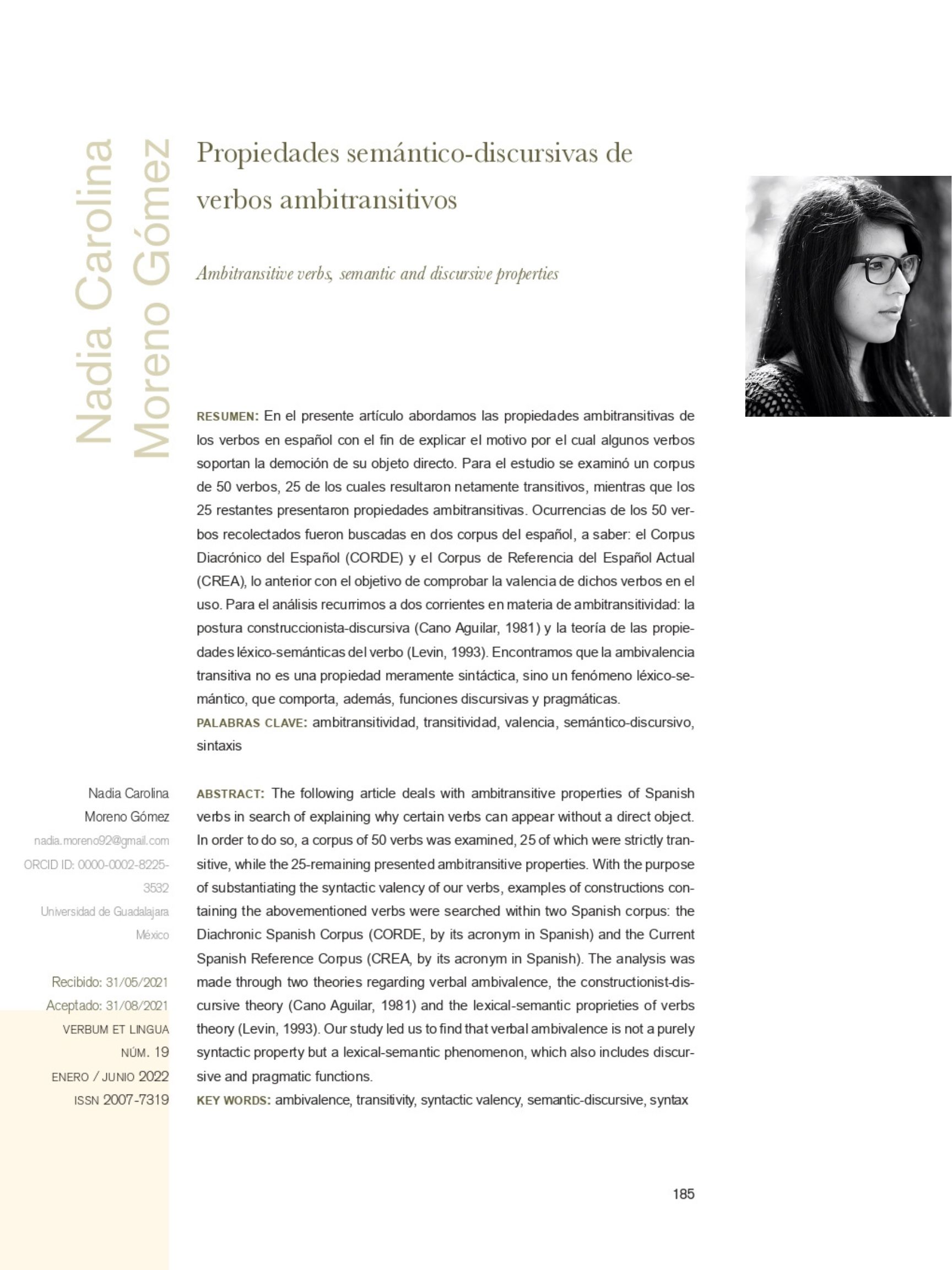Propiedades Semántico-discursivas de Verbos Ambitransitivos
DOI:
https://doi.org/10.32870/vel.vi19.179Palabras clave:
Ambitransitividad, Transitividad, Valencia, Semántico-discursivo, SintaxisResumen
En el presente artículo abordamos las propiedades ambitransitivas de los verbos en español con el fin de explicar el motivo por el cual algunos verbos soportan la democión de su objeto directo. Para el estudio se examinó un corpus de 50 verbos, 25 de los cuales resultaron netamente transitivos, mientras que los 25 restantes presentaron propiedades ambitransitivas. Ocurrencias de los 50 verbos recolectados fueron buscadas en dos corpus del español, a saber: el Corpus Diacrónico del Español (CORDE) y el Corpus de Referencia del Español Actual (CREA), lo anterior con el objetivo de comprobar la valencia de dichos verbos en el uso. Para el análisis recurrimos a dos corrientes en materia de ambitransitividad: la postura construccionista-discursiva (Cano Aguilar, 1981) y la teoría de las propiedades léxico-semánticas del verbo (Levin, 1993). Encontramos que la ambivalencia transitiva no es una propiedad meramente sintáctica, sino un fenómeno léxico-semántico, que comporta, además, funciones discursivas y pragmáticas.
Descargas
Métricas
Citas
Bohrn, Andrea (2010). Verbos transitivos y sus objetos: sobre la posibilidad de omitir Complementos. En IX Congreso Argentino de Hispanistas 27 al 30 de abril de 2010 La Plata, Argentina. El hispanismo ante el bicentenario. Asociación Argentina de Hispanistas.
Campos, Hector (1999) Transitividad e intransitividad. En Bosque, Ignacio/ Demonte, Violeta (eds.) Gramática descriptiva de la lengua española. Vol. 2: Las construcciones sintácticas fundamentales. Relaciones temporales, aspectuales y modales. (Pp. 1519-1574). Madrid: Espasa.
De Miguel, Elena (1999) “El aspecto léxico”. En Bosque, Ignacio/ Demonte, Violeta (eds.) Gramática descriptiva de la lengua española. Vol. 2: Las construcciones sintácticas fundamentales. Relaciones temporales, aspectuales y modales. (Pp. 2977-3060). Madrid: Espasa.
Dixon, Robert (2010a), Basic Linguistic Theory Volume 1: Grammatical Topics. Oxford: Oxford.
Dixon, Robert (2010b) Basic Linguistic Theory. Vol. 2, Grammatical topics. Oxford: Oxford University Press.
Hopper, Paul J. & Thompson, Sandra A. (1980) Transitivity in Grammar and Discourse. Language, 2: 251-299.
Ibáñez, S., & Melis, C. (2016). “Ambivalencia transitiva y estructura argumental: resultados de un estudio de uso”. Anuario de Letras. Lingüística y Filología, 2: 153-198.
Levin, Beth (1993). English verb classes and alternations: A preliminary investigation. University of Chicago press.
Moreno Cabrera, J.C. (1991), Curso Universitario de Lingüística General Tomo 1: Teoría de la Gramática y Sintaxis General, University Press. España.
Payne, Thomas (1997). Describing morphosyntax: A guide for field linguists. Cambridge University Press.
Thompson, Sandra A. y Paul J. Hopper (2001), Transitivity, clause structure, and argument structure: Evidence from conversation. En J. L. Bybee y P. J. Hopper (eds.), Frequency and the emergence of linguistic structure. (Pp. 27-59). A?msterdam, John Benjamins.
Yasutake, Tomoko (1987) Objectless Transitives in English. The Bulletin of Aichi University of Education, 36: 43-55.

Publicado
Versiones
- 2024-09-06 (2)
- 2022-06-21 (1)













